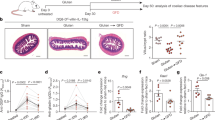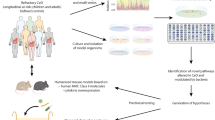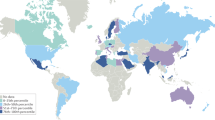Abstract
Celiac disease is a genetic inflammatory disorder with autoimmune components that is induced by the ingestion of dietary gluten. Refractory sprue and enteropathy-associated T-cell lymphoma are rare but distinctive complications of the disease. Although the importance of the adaptive immune response to gluten has been well established, observations now also point towards a central role for the gluten-induced innate stress response in the pathogenesis of celiac disease and its malignant complications.
Key Points
-
Celiac disease is an inflammatory disorder with an autoimmune component
-
The molecular basis for the role of HLA-DQ2, HLA-DQ8, and transglutaminase 2 are now better defined, as is the role of intraepithelial lymphocytes and natural killer receptors
-
There is emerging evidence that the adaptive and innate immune responses to gluten might exist independently and are both required to induce epithelial cell destruction, which results in villous atrophy and clinical symptoms related to malabsorption
This is a preview of subscription content, access via your institution
Access options
Subscribe to this journal
Receive 12 print issues and online access
$209.00 per year
only $17.42 per issue
Buy this article
- Purchase on Springer Link
- Instant access to full article PDF
Prices may be subject to local taxes which are calculated during checkout


Similar content being viewed by others
References
Green PH and Jabri B (2003) Coeliac disease. Lancet 362: 383–391
MacDonald TT et al. (1999) T cells orchestrate intestinal mucosal shape and integrity. Immunol Today 20: 505–510
Ferguson A et al. (1976) Intraepithelial lymphocyte counts in small intestinal biopsies from children with diarrhoea. Acta Paediatr Scand 65: 541–546
Marsh MN (1992) Gluten, major histocompatibility complex, and the small intestine. A molecular and immunobiologic approach to the spectrum of gluten sensitivity ('celiac sprue'). Gastroenterology 102: 330–354
Dieterich W et al. (1997) Identification of tissue transglutaminase as the autoantigen of celiac disease. Nature Med 3: 797–801
Sollid LM (2002) Coeliac disease: Dissecting a complex inflammatory disorder. Nature Reviews Immunology 2: 647–655
Sardy M et al. (2002) Epidermal transglutaminase (TGase 3) is the autoantigen of dermatitis herpetiformis. J Exp Med 195: 747–757
Catassi C et al. (1996) The coeliac iceberg in Italy. A multicentre antigliadin antibodies screening for coeliac disease in school-age subjects. Acta Paediatr Suppl 412: 29–35
Green PH and Jabri B (2002) Celiac disease and other precursors to small-bowel malignancy. Gastroenterol Clin North Am 31: 625–639
Sollid LM and Jabri B (2005) Is celiac disease an autoimmune disorder? Curr Opin Immunol 17: 595–600
Ventura A et al. (1999) Duration of exposure to gluten and risk for autoimmune disorders in patients with celiac disease. SIGEP Study Group for Autoimmune Disorders in Celiac Disease. Gastroenterology 117: 297–303
Viljamaa M et al. (2005) Coeliac disease, autoimmune diseases and gluten exposure. Scand J Gastroenterol 40: 437–443
Sollid LM and Lie BA (2005) Celiac disease genetics: current concepts and practical applications. Clin Gastroenterol Hepatol 3: 843–851
Sollid LM and Thorsby E (1993) HLA susceptibility genes in celiac disease: genetic mapping and role in pathogenesis. Gastroenterology 105: 910–922
Ploski R et al. (1993) On the HLA-DQ(α1*0501, β1*0201)-associated susceptibility in celiac disease: a possible gene dosage effect of DQB1*0201. Tissue Antigens 41: 173–177
Vader W et al. (2003) The HLA-DQ2 gene dose effect in celiac disease is directly related to the magnitude and breadth of gluten-specific T cell responses. Proc Natl Acad Sci USA 100: 12390–12395
Nistico L et al. (2006) Concordance, disease progression, and heritability of coeliac disease in Italian twins. Gut 55: 803–808
Mearin ML et al. (1983) HLA-DR phenotypes in Spanish coeliac children: their contribution to the understanding of the genetics of the disease. Gut 24: 532–537
van Heel DA et al. (2005) Genetics in coeliac disease. Best Pract Res Clin Gastroenterol 19: 323–339
Babron MC et al. (2003) Meta and pooled analysis of European coeliac disease data. Eur J Hum Genet 11: 828–834
van Belzen MJ et al. (2003) A major non-HLA locus in celiac disease maps to chromosome 19. Gastroenterology 125: 1032–1041
Monsuur AJ et al. (2005) Myosin IXB variant increases the risk of celiac disease and points toward a primary intestinal barrier defect. Nature Genet 37: 1341–1344
Hunt KA et al. (2006) Lack of association of MYO9B genetic variants with coeliac disease in a British cohort. Gut 55: 969–972
Amundsen SS et al. (2006) Association analysis of MYO9B gene polymorphisms with celiac disease in a Swedish/Norwegian cohort. Hum Immunol 67: 341–345
van Elburg RM et al. (1993) Intestinal permeability in patients with coeliac disease and relatives of patients with coeliac disease. Gut 34: 354–357.
Wirth JA et al. (1996) Human myosin-IXb, an unconventional myosin with a chimerin-like rho/rac GTPase-activating protein domain in its tail. J Cell Sci 109: 653–661
Cataldo F et al. (1998) Prevalence and clinical features of selective immunoglobulin A deficiency in coeliac disease: an Italian multicentre study. Italian Society of Paediatric Gastroenterology and Hepatology (SIGEP) and “Club del Tenue” Working Groups on Coeliac Disease. Gut 42: 362–365
Castigli E et al. (2005) TACI is mutant in common variable immunodeficiency and IgA deficiency. Nature Genet 37: 829–834
Lundin KE et al. (1993) Gliadin-specific, HLA-DQ(α1*0501, β1*0201) restricted T cells isolated from the small intestinal mucosa of celiac disease patients. J Exp Med 178: 187–196
Lundin KE et al. (1994) T cells from the small intestinal mucosa of a DR4, DQ7/DR4, DQ8 celiac disease patient preferentially recognize gliadin when presented by DQ8. Hum Immunol 41: 285–291
Johansen BH et al. (1996) Identification of a putative motif for binding of peptides to HLA-DQ2. Int Immunol 8: 177–182
van de Wal Y et al. (1996) Peptide binding characteristics of the coeliac disease-associated DQ(α1*0501, β1*0201) molecule. Immunogenetics 44: 246–253
Kwok WW et al. (1996) Allele-specific motifs characterize HLA-DQ interactions with a diabetes-associated peptide derived from glutamic acid decarboxylase. J Immunol 156: 2171–2177
Suri A et al. (2005) Natural peptides selected by diabetogenic DQ8 and murine I-A(g7) molecules show common sequence specificity. J Clin Invest 115: 2268–2276
Molberg O et al. (1998) Tissue transglutaminase selectively modifies gliadin peptides that are recognized by gut-derived T cells in celiac disease. Nature Med 4: 713–717
van de Wal Y et al. (1998) Selective deamidation by tissue transglutaminase strongly enhances gliadin-specific T cell reactivity. J Immunol 161: 1585–1588
Fleckenstein B et al. (2002) Gliadin T cell epitope selection by tissue transglutaminase in celiac disease. Role of enzyme specificity and pH influence on the transamidation versus deamidation process. J Biol Chem 277: 34109–34116
Vader LW et al. (2002) Specificity of tissue transglutaminase explains cereal toxicity in celiac disease. J Exp Med 195: 643–649
Shan L et al. (2002) Structural basis for gluten intolerance in celiac sprue. Science 297: 2275–2279
Shan L et al. (2005) Identification and analysis of multivalent proteolytically resistant peptides from gluten: implications for celiac sprue. J Proteome Res 4: 1732–1741
Arentz-Hansen H et al. (2004) The molecular basis for oat intolerance in patients with celiac disease. PLoS Med 1: e1
Qiao SW et al. (2005) Refining the rules of gliadin T cell epitope binding to the disease-associated DQ2 molecule in celiac disease: importance of proline spacing and glutamine deamidation. J Immunol 175: 254–261
Kim CY et al. (2004) Structural basis for HLA-DQ2-mediated presentation of gluten epitopes in celiac disease. Proc Natl Acad Sci USA 101: 4175–4179
Moustakas AK et al. (2000) Structure of celiac disease-associated HLA-DQ8 and non-associated HLA-DQ9 alleles in complex with two disease-specific epitopes. Int Immunol 12: 1157–1166
Tollefsen S et al. HLA-DQ2 and -DQ8 signatures of gluten T cell epitopes in celiac disease. J Clin Invest 116: 2226–2236
Sollid LM et al. (1997) Autoantibodies in coeliac disease: tissue transglutaminase—guilt by association? Gut 41: 851–852
Fleckenstein B et al. (2004) Molecular characterization of covalent complexes between tissue transglutaminase and gliadin peptides. J Biol Chem 279: 17607–17616
Mohan K et al. (2003) Identification of tissue transglutaminase as a novel molecule involved in human CD8+ T cell transendothelial migration. J Immunol 171: 3179–3186
Maiuri L et al. (2005) Unexpected role of surface transglutaminase type II in celiac disease. Gastroenterology 129: 1400–1413
Le Naour F et al. (2001) Profiling changes in gene expression during differentiation and maturation of monocyte-derived dendritic cells using both oligonucleotide microarrays and proteomics. J Biol Chem 276: 17920–17931
Akimov SS and Belkin AM (2001) Cell surface tissue transglutaminase is involved in adhesion and migration of monocytic cells on fibronectin. Blood 98: 1567–1576
Marietta E et al. (2004) A new model for dermatitis herpetiformis that uses HLA-DQ8 transgenic NOD mice. J Clin Invest 114: 1090–1097
Kaukinen K et al. (2005) Small-bowel mucosal transglutaminase 2-specific IgA deposits in coeliac disease without villous atrophy: a prospective and randomized clinical study. Scand J Gastroenterol 40: 564–572
Gianfrani C et al. (2003) Celiac disease association with CD8+ T cell responses: identification of a novel gliadin-derived HLA-A2-restricted epitope. J Immunol 170: 2719–2726
Hue S et al. (2004) A direct role for NKG2D/MICA interaction in villous atrophy during celiac disease. Immunity 21: 367–377
Meresse B et al. (2004) Coordinated induction by IL15 of a TCR-independent NKG2D signaling pathway converts CTL into lymphokine-activated killer cells in celiac disease. Immunity 21: 357–366
Meresse B et al. (2006) Reprogramming of CTL into natural killer-like cells in celiac disease. J Exp Med 203: 1343–1355
Roberts AI et al. (2001) NKG2D receptors induced by IL-15 costimulate CD28-negative effector CTL in the tissue microenvironment. J Immunol 167: 5527–5530
Jabri B et al. (2000) Selective expansion of intraepithelial lymphocytes expressing the HLA-E-specific natural killer receptor CD94 in celiac disease. Gastroenterology 118: 867–879
Mention JJ et al. (2003) Interleukin 15: a key to disrupted intraepithelial lymphocyte homeostasis and lymphomagenesis in celiac disease. Gastroenterology 125: 730–745
Bauer S et al. (1999) Activation of NK cells and T cells by NKG2D, a receptor for stress-inducible MICA. Science 285: 727–729
Braud VM et al. (1998) HLA-E binds to natural killer cell receptors CD94/NKG2A, B and C. Nature 391: 795–799
Lee N et al. (1998) HLA-E is a major ligand for the natural killer inhibitory receptor CD94/NKG2A. Proc Natl Acad Sci USA 95: 5199–5204
Nikulina M et al. (2004) Wheat gluten causes dendritic cell maturation and chemokine secretion. J Immunol 173: 1925–1933
Palova-Jelinkova L et al. (2005) Gliadin fragments induce phenotypic and functional maturation of human dendritic cells. J Immunol 175: 7038–7045
Ogasawara K et al. (2004) NKG2D blockade prevents autoimmune diabetes in NOD mice. Immunity 20: 757–767
Turley S et al. (2003) Physiological beta cell death triggers priming of self-reactive T cells by dendritic cells in a type-1 diabetes model. J Exp Med 198: 1527–1537
Turley SJ et al. (2005) Endocrine self and gut non-self intersect in the pancreatic lymph nodes. Proc Natl Acad Sci USA 102: 17729–17733
Jabri B et al. (2005) Innate and adaptive immunity: the yin and yang of celiac disease. Immunol Rev 206: 219–231
Troncone R et al. (1996) In siblings of celiac children, rectal gluten challenge reveals gluten sensitization not restricted to celiac HLA. Gastroenterology 111: 318–324
Maiuri L et al. (2003) Association between innate response to gliadin and activation of pathogenic T cells in coeliac disease. Lancet 362: 30–37
Lang KS et al. (2005) Toll-like receptor engagement converts T-cell autoreactivity into overt autoimmune disease. Nature Med 11: 138–145
Sollid LM and Vaage JT (2006) Cross-dressing T cells go wild. Nature Med 12: 611–612
Lee SK et al. (2003) Duodenal histology in patients with celiac disease after treatment with a gluten-free diet. Gastrointest Endosc 57: 187–191
Wahab PJ et al. (2002) Histologic follow-up of people with celiac disease on a gluten-free diet: slow and incomplete recovery. Am J Clin Pathol 118: 459–463
Cellier C et al. (2000) Refractory sprue, coeliac disease, and enteropathy-associated T-cell lymphoma. French Coeliac Disease Study Group. Lancet 356: 203–208
Isaacson PG (2000) Relation between cryptic intestinal lymphoma and refractory sprue. Lancet 356: 178–179
Fehniger TA et al. (2001) Fatal leukemia in interleukin 15 transgenic mice follows early expansions in natural killer and memory phenotype CD8+ T cells. J Exp Med 193: 219–231
Sollid LM and Khosla C (2005) Future therapeutic options for celiac disease. Nat Clin Pract Gastroenterol Hepatol 2: 140–147
Acknowledgements
We thank the members of our laboratories for their input and discussions in preparation of the manuscript. We also thank the University of Chicago Celiac Center and The Columbia Presbyterian Hospital Celiac Center for their support. The work in the authors' laboratories is supported by the NIH (University of Chicago DDRCC P30 DK42086, RO1 DK58727 and RO1 DK063158) and the Research Council of Norway, the University of Oslo, the Rikshospitalet-Radiumhospitalet Medical Center, and the EU (QLK1-CT-2000-00657).
Author information
Authors and Affiliations
Corresponding authors
Ethics declarations
Competing interests
The authors declare no competing financial interests.
Rights and permissions
About this article
Cite this article
Jabri, B., Sollid, L. Mechanisms of Disease: immunopathogenesis of celiac disease. Nat Rev Gastroenterol Hepatol 3, 516–525 (2006). https://doi.org/10.1038/ncpgasthep0582
Received:
Accepted:
Issue Date:
DOI: https://doi.org/10.1038/ncpgasthep0582
This article is cited by
-
Individual variability in patterns and dynamics of fecal gluten immunogenic peptides excretion after low gluten intake
European Journal of Nutrition (2022)
-
Clinical-Pathological Conference Series from the Medical University of Graz
Wiener klinische Wochenschrift (2020)
-
IL-15, gluten and HLA-DQ8 drive tissue destruction in coeliac disease
Nature (2020)
-
Responsive population dynamics and wide seeding into the duodenal lamina propria of transglutaminase-2-specific plasma cells in celiac disease
Mucosal Immunology (2016)
-
Novel avian single-chain fragment variable (scFv) targets dietary gluten and related natural grain prolamins, toxic entities of celiac disease
BMC Biotechnology (2015)



